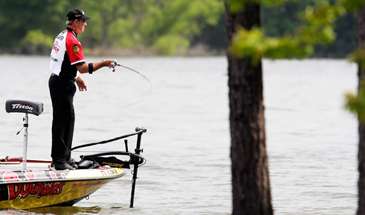
Spinnerbaits are some of the most versatile baits available to anglers. They can mimic many types of baitfish, are virtually weedless and can be fished top to bottom in the water column. In this story we're going to focus on the lowest kind of spinnerbaiting — slow rolling.
Cherryville, N.C.'s Guy Eaker is the most senior angler to ever compete at BASS' highest level. He has been doing so since 1979. Along the way he has pioneered many baits and seen plenty of techniques fall in and out of favor. Here he details one of his all-time favorites: slow rolling a spinnerbait in deep water.
"Usually when you're fishing a spinnerbait, you're burning it over grass or trees or around logs, imitating a minnow," Eaker says. "A spinnerbait by itself doesn't look like much swimming, it's the sound the blades make in the water that makes it sound like a baitfish swimming. Slow rolling is different. It's usually a lot slower and can be harder to do correctly.
"When I worked for Bagley Bait Co., we listened to shad and minnows in a tank and found that a combination of a willow leaf and a Colorado blade sound exactly like one of them moving in the water," Eaker explains. "That's what I use when I'm slow rolling. I created the Diamond Head spinnerbait for just that. I've caught 56 bass over 10 pounds, and 80 percent of them came on a Diamond Head."
Original Diamond Head spinnerbaits are difficult to find, but you can get genuine reproductions at www.erlures.com. Eaker says he uses anywhere from a 3/4- to 1-ounce spinnerbait but keeps his blade size to a minimum. He has learned from biologists that a bass' system won't allow it to eat big forage in cold months without spitting it up. This is why he doesn't go larger than No. 5 blades.
His slow rollers have a No. 3 silver Colorado blade in front of a gold No. 4 1/2 or 5 willow. In water 57 degrees and below, he switches to two Colorado blades, a No. 3 and a No. 4. This combo has a little different sound and a lot more "thump." He'll slow his retrieve down to a crawl in water measuring 57 degrees and below.
A sensitive rod is important to keep in contact with the turning blades. Eaker likes a 7-foot, medium-heavy Fenwick Elite Tech rod (medium action for lighter, 1/4-ounce baits) with 15- to 20-pound-test Trilene 100% Fluorocarbon. He spools it up on an Abu Garcia Revo STX or Revo Premier reel.
Eaker will cut the skirt off right behind the hook and slide a white 3-inch Berkley grub on the back to give it a more lifelike appearance. For spinnerbaits 3/8 ounce and heavier, he uses a 4-inch grub. To remedy short strikes before they happen, a 1/0 trailer hook is hung on the back as well. His favorite colors are chartreuse and white for dirty water and white with blue glimmer for clean water.
Most slow rolling is done in deep water, but depth is a relative thing. On most Florida lakes, 20 feet is considered deep. Several places on Lake Mead in Nevada are 500 feet deep. Of course you'd never throw a spinnerbait (or any bass bait) that deep, but know how deep bass will congregate in any given season.
When slow rolling a spinnerbait, Eaker says there are a few critical points to remember.
First, your bait had better be contacting the structure or cover you're fishing.
"If you're slow rolling over grass, you'd better be bumping into the grass every once in a while. If you're fishing over trees, let it dip into the branches occasionally," he says. "Shad like to hang around trees and eat algae, so a spinnerbait bumped into a limb sounds like a shad leaving the tree.
"If you're fishing hard bottom, keep it scraping. If it comes to a depression or dropoff, don't quit winding. You've got to keep the blades going," he says.
Eaker stresses that you need to "pop" the bait into motion as soon as it hits the water. Also, keep the rod tip pointed at the bait and never quit winding.
"About the worst thing you can do is to let it hit the water dead. Nothing falls into the water dead then comes to life. Bass have heard shad flicking and running around on the surface their whole loves, so when you plop a spinnerbait in there and don't do anything, it appears dead." he says. "Get the blades moving then keep them going until it hits bottom and start your retrieve.
"I usually retrieve it fast enough to keep the blades spinning. You should be able to feel it in your rod," Eaker says. "If you feel mush, you'd better be setting the hook because that's a fish. They can blow it out as quickly as they sucked it in."




